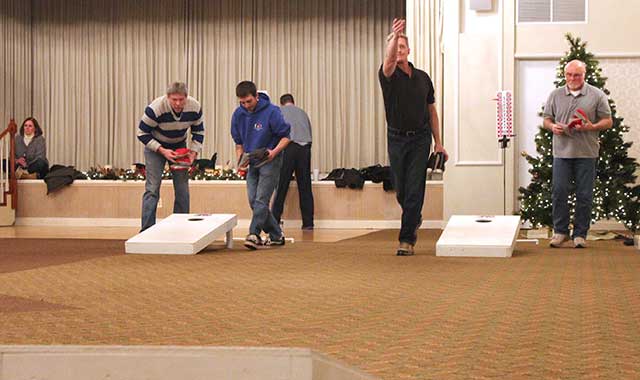Call it bags, bean bag toss, cornhole — but don’t say it’s not competitive. Discover a Crystal Lake league where every bean bag counts.

Over the years, Ted Niedbalec has enjoyed participating in a variety of sports, including baseball, softball and bowling. These days, however, he gets his thrills by tossing around a bean bag.
“I love it,” says the Algonquin resident. “It’s a great way to socialize with people, whether they’re competitive or not. I was hooked the first time I threw a bag.”
Bags, also known as bean bag toss, baggo or cornhole, is a popular game that can be played indoors or out, in which players take turns throwing bags at a slanted wooden board with a hole in the high end.
“It’s become so popular because anyone can play,” says Joe Davison, recreation supervisor for the Crystal Lake Park District. “You can be male or female, young or old. And it’s not complicated to play.”
The rules of the game are fairly simple. The bag can be tossed directly into the hole, slide into the hole or be knocked into the hole by another bag. If you toss the bag into the hole, it’s worth three points. If the bag stays on top of the box, the throw earns one point. If a bag touches the ground and comes to rest on the board, it is not worth any points, and is removed before play continues. If your opponent matches your toss – in the hole or on the board – the points are negated. The first player to gain 21 points wins the match; the best of three matches wins the game.
“It takes skill, practice and accuracy to place the bag on the board,” says Niedbalec. “There are a lot of good players out there. You also need to have confidence in yourself.”
Not much is known about the history of the game. It’s largely believed that the game was first played in Germany during the 14th century. Others believe that Native Americans, including the Blackhawk tribe from Illinois, played a similar game.
These days, bags is a favorite pastime that can be played at tailgate parties, family reunions, Fourth of July picnics or most any other occasion.
The Crystal Lake Park District started a league four years ago, as a way to offer residents additional weekday programming. Participants travel from all over the area to play in the park district’s Thursday night league, which plays on four courts at the park district’s Park Place banquet facility, 406 Woodstock St.
“We were trying to come up with programs that would be successful during a time when the facility wasn’t busy,” says Davison, who starting playing bags in college. “Park Place is busy on weekends for weddings and showers, but not during weeknights. Having a Thursday night bags league has worked well for us, as well as for the community.”
The park district holds nine-week indoor leagues during winter, spring and fall months, as well as a special tournament during Crystal Lake’s annual summer festival at Main Beach.
The cost per seasonal session is $80 per resident team, and $90 for non-residents. The league fluctuates between eight and 16 men’s, women’s and co-ed teams. Most players are men, although eight women currently participate. The winning team in each session earns a prize package.
Teams include two players and one alternate, and they play under a variety of creative nicknames, including The Foreclosures, Team Awesome and the Bag Ladies. “We have realtors, doctors, mechanics, retirees play – it’s across the board,” says Davison. “We even have park district employees who like to play. Bags appeals to all walks of life.”
Besides cool team names, there’s plenty of other creative terminology involved. An ace or cow pie is a bag that lands on the board. A screaming eagle is a bag that goes past the board without hitting it. A sally is a weak throw that lands on the ground before reaching the board. A shucker is when a player’s bag strikes an opposing player’s bag, knocking it off the board. A swish goes directly in the hole, without touching the board.
Niedbalec discovered bags four years ago, during his son’s little league baseball team picnic. He played a match against another father, Jeremy Copeland, of Algonquin, and the baseball dads immediately hit it off. “We got to talking, decided to form a team and try our luck against other competition,” says Niedbalec, a mortgage lender.
While the park district league is played purely for fun, Niedbalec has won prize money in various bags tournaments held in Huntley, Johnsburg, Rockford and Roselle. But Niedbalec also owns a couple of sets, to play with family and neighbors.
“I love to play and compete,” he says. “If you beat me, great. But I will want to play you again.”
In bags, players toss 16-once bean bags, filled with material such as crushed rock, poly resin or unpopped corn kernels. Each platform board is 4 feet long by 2 feet wide, with a 6-inch hole centered 9 inches from the top. A regulation court places the holes 33 feet apart. Shorter distances can be used when younger players are participating, or if you’re lacking for space. Players must stand to the side of the opposite board, and their foot can’t extend past the front of the board.
The Crystal Lake Park District league follows the rules implemented by the American Cornhole Organization (ACO). The ACO, founded in Cincinnati in 2004, is the official governing body for the sport, promoting professional and recreational tournaments and leagues around the country.
The biggest name in bags is Matt Guy, a Butternut Bakery supervisor from Cincinnati. Niedbalec has shot against Guy a couple of times, during warm-ups at local tournaments. “It was fun rubbing shoulders with a big gun like him,” says Niedbalec.
But you don’t have to be a pro to have fun playing bags. Most people play for the comradery.
“It’s like a big family,” says Davison. “Many of these people have been playing together for years. Everyone knows each other. If someone hears about an area tournament and their partner isn’t available, they have the phone numbers of other players to call.”
Park district officials and participants alike hope more people will start to turn out for the various leagues. The park district has upgraded its equipment, replacing corn-filled bags with more expensive sticky suede options, which players say has improved the quality of play.
Davison is also open to the possibility of expanding leagues, if the need arises. “Four years ago, we were the only game in town,” he says. “Now, there are plenty of bars that host tournaments and leagues. Still, there are people who don’t realize there are competitive leagues. We would love to see our leagues grow, at least by one or two teams.”
Niedbalec would welcome the additional competition, and the chance to meet new people who share his passion. “It’s a great icebreaker and a fun game to play,” he says. “It’s something I look forward to doing well into my old age.”





















































